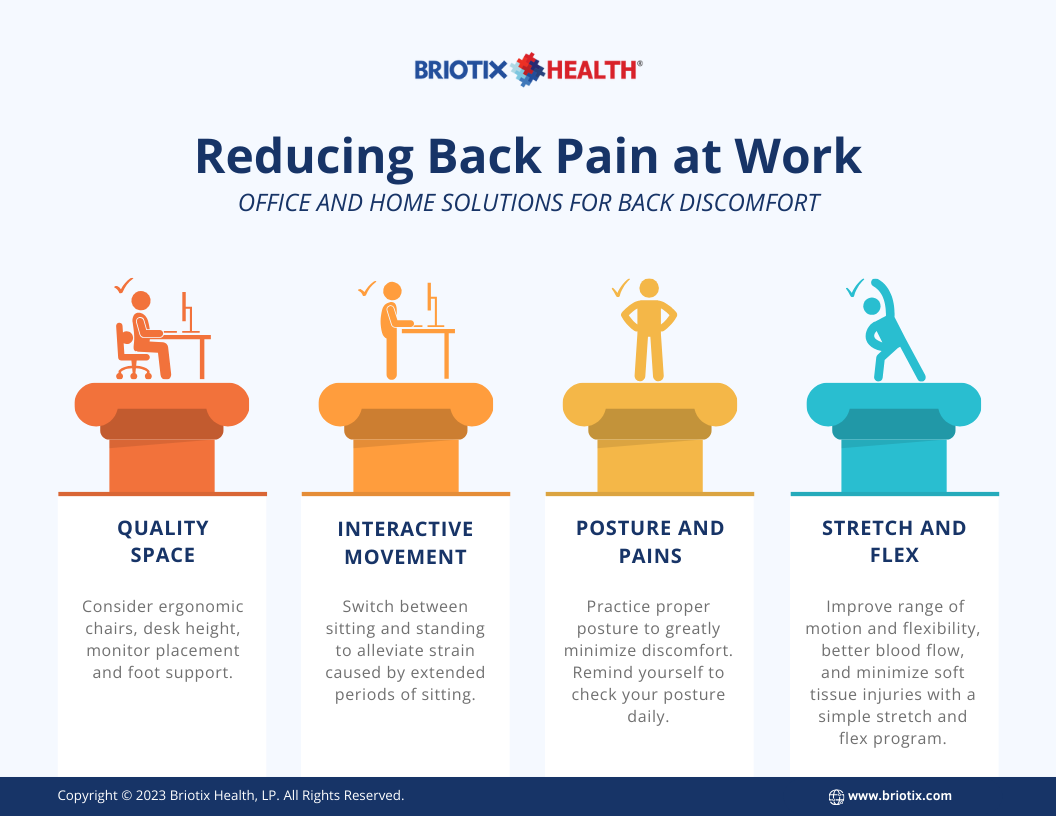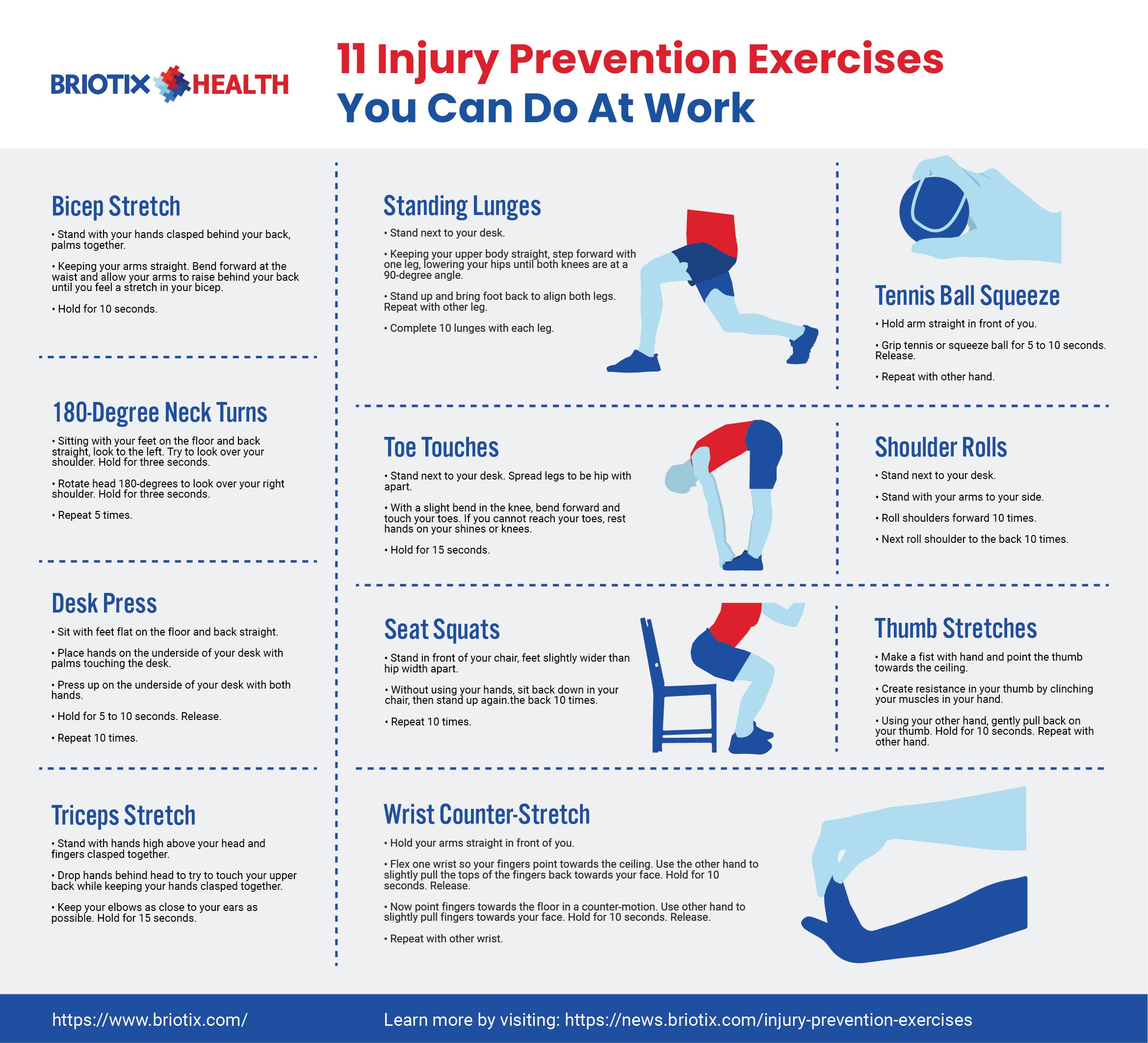As the shift to remote work evolves and many are returning to the office, it is important to refresh on those common tips that keep you free of discomfort. During this Wellness Month set aside time to consider your current initiatives and where you can make improvements! In whatever environment you happen to be doing your work - home office, the couch, a shared workspace, or a new office - one of your first considerations should be your well-being.
To ensure your comfort and productivity, it is essential to implement practical strategies to reduce back pain and promote a healthier work environment. You spend a third of every one of your days at work or in the workplace. Acknowledging and addressing the most common causes and symptoms of musculoskeletal discomfort should be a high priority. Decreasing discomfort has been shown to increase productivity, health, and happiness!
In this blog, we will cover the common causes of discomfort in the work environment that can impact your levels of comfort, tips to maximize your workspace for ergonomic efficiency, and how wellness can become an easy endeavor with collaboration.
Skip Ahead:
Quality Space: Adjusting Your Work Environment
Interactive Movement: Understanding Your Desk
Posture and Pains: Become the Expert
Stretch and Flex: Injury Prevention with Movement

The impact and causes of back pain and discomfort in the workplace are varied and can range in intensity. Employees suffering from chronic back pain often experience a significant decline in productivity and engagement, leading to decreased work efficiency and effectiveness as found in this study by Gedin et al.. Absenteeism and reduced levels of productivity become common occurrences, as employees may be forced to take sick leave or continue working despite their pain, which further hampers their ability to perform at their best.
Chronic discomforts can negatively affect employee morale and job satisfaction, leading to increased stress levels and a higher likelihood of employee turnover. Training new employees after losing an experienced worker can cost a company between $7500 and $28,000 in addition to soft costs of 60% of the cost to hire from lost productivity and take over a month just to acquire new talent according to BambooHR. Employees who you retain will still require additional healthcare costs and their discomforts may evolve into claims if not addressed properly.
With proactive measures created to address common risk factors, employers can foster a culture that prioritizes employee health and happiness, resulting in a more motivated, engaged, and thriving workforce.
Quality Space: Adjusting Your Work Environment
Creating a discomfort-free and ergonomic workspace has become a major topic of discussion, with organizations like the New York Times and other large businesses getting involved, in today’s world. Being cognizant of your environment can significantly reduce the risk of suffering an injury and can contribute to better overall health. When considering your workspace, take into account these points of interest:
- Ergonomic Chairs: Investing in a quality ergonomic chair that provides proper lumbar support, encourages a neutral sitting position, and allows for adjustments to match your height and desk level all can be a major benefit to your wellness. Armrests that properly support you can also help relieve strain from your upper back and shoulders.
- Desk Height: Ensure your desk height allows your arms to rest comfortably, forming a 90-degree angle at your elbows. Keep your keyboard and mouse at the same level to avoid strains from movements and awkward positioning.
- Monitor Position: Adjust your computer screen to eye level, as straining your neck and shoulders while looking at the screen can cause increased discomfort across your entire body. Maintain a distance of about an arm's length from the monitor to reduce eye strain from consistent use.
- Sole Support: Keeping your feet flat on the ground or using a footrest to maintain a comfortable sitting posture will reduce your discomfort from increased pressure on your lower back. This can be helped with an ergonomic chair mentioned in the previous bullets!
The University of New Hampshire has published a detailed guide on identifying and utilizing ergonomic office solutions. There are many adjustments that can be made to improve the quality of your workspace, so find the one that work for you!
Interactive Movement: Understanding Your Desk

A workspace has a variety of tools and items that you are constantly interacting with. Pens, paper, computers, laptops, phones, and more will be in a variety of places based on your needs. But constant movement and adjustments to interact with these objects can become a source of discomfort.
Daily use items would not be considered heavy objects but rather things you might carry in a pocket or grab on the go. No need for heavy lifting here. Consider the following adjustments:
- Frequent Reaching: You can avoid excessive twisting and reaching, responsible for potential strains or stresses on your back muscles, by keeping commonly used items within arm’s reach. Having a chair that can twist can also assist if your desk extends around you.
- Phones and Accessories: By keeping pens and notebooks, phones, and other small objects within reach of your dominant hand you can minimize unnecessary movements.
- Document Placement: If you are experiencing frequent neck strain from tilting or leaning your head to view documents you can use a document holder to elevate them to eye level.
- Dynamic Workstations: A desk set-up that allows you to alternate between sitting and standing positions can reduce pressure on your back from long periods of continuous sitting. Taking breaks by alternating your working position can also help increase blood flow as well.
Posture and Pains: Become the Expert
By adopting and maintaining good posture techniques you can significantly reduce the chances of discomfort. Bad posture can have cascading effects across your musculoskeletal system, including surprising ones like increased chances of heartburn as seen in this article by Harvard. Adopt these practices to improve your posture:
- Maintain a Neutral Spine: Keep your back straight and shoulders relaxed while sitting and avoid slouching or rounding your spine. Building up your core muscles over time can help with poor posture and maintaining this position.
- Lumbar Support: Utilize a lumbar support cushion or an ergonomic chair with built-in lumbar support to maintain the natural curve of your lower back and reduce pressure. Chair replacements, like an exercise ball, can be good for building core muscles but backrests which can be a contributor to low back pain over time.
- Posture Check: Occasionally reminding yourself to check your posture throughout the day can significantly improve your posture! Consider setting an alarm to remind yourself to occasionally check your posture. Going long periods of time with bad posture is what causes the most issues, so adjust when you can!
- Standing Posture: Just because you aren’t sitting doesn’t mean you can forget all about your posture. Dynamic posture, posture while you are moving, can affect flexibility, balance, and more. Building up your core strength and adding movement to your daily routine can help reduce the risk of back injuries.
Stretch and Flex: Injury Prevention with Movement
An JAT study found that implementing a stretching program is capable of reducing the occurrence of musculoskeletal disorders by at least 5%. Improving range of motion and flexibility, better blood flow, and minimizing soft tissue injuries can all be achieved with a simple stretch and flex program.

Reducing back pain at work is not only essential for your physical well-being but also vital for maintaining productivity and focus. By implementing the tips covered in this blog - adjusting your desk and chair for ergonomic efficiency, creating an interactive workspace, prioritizing proper posture, and incorporating regular stretching and movement - you can create a more comfortable and healthier work environment.
If you are looking for an ergonomic assessment to understand your risk for work-related back problems or poor posture, Briotix Health providers can give you a comprehensive solution. Contact a solutions provider below!